
Do you have a product concept in mind? Are you willing to shape it and head straight to the development process? Test the waters first and get your idea validated.
Many companies struggle to decide whether creating an MVP (minimum viable product ) or MMP (minimum marketable product) or any other type of a minimum product is the right way to start. With so many stages for a tech product startup, it’s hard to decide on the right workflow. But each of them serves a specific goal and brings you closer to the desired product.
Start with a prototype, follow with an MVP and get to the product.
First things first, start with building a product prototype. A prototype doesn’t contain any features and works as a model or release of your idea. It helps to test the concept and build a base for an MVP. A minimum viable product instead has a set of sufficient features to satisfy early adopters. It is designed after initial users leave their feedback about the product. Along with that, there are also minimum marketable product, minimum loveable product and other variations of what is to become a final version of your product.
In this article, we’ll help you distinguish the starting and end points for the software product development and guide you through the MVP, MMP, MLP, MDP, and MAP startup stages. You’ll get a better understanding of what MVP is in software development and how to build it right.
Read further to know how to properly utilize this terminology and which one would serve your needs the best.
Getting Familiar with the Main Startup Development Stages
Every new company experiences certain lifecycle stages and it may be tricky to identify them at first. Yet, once you know what to expect — your chances to succeed increase.
Here’s an easy breakdown of the main startup stages and an overview of how they influence a new tech company’s development.
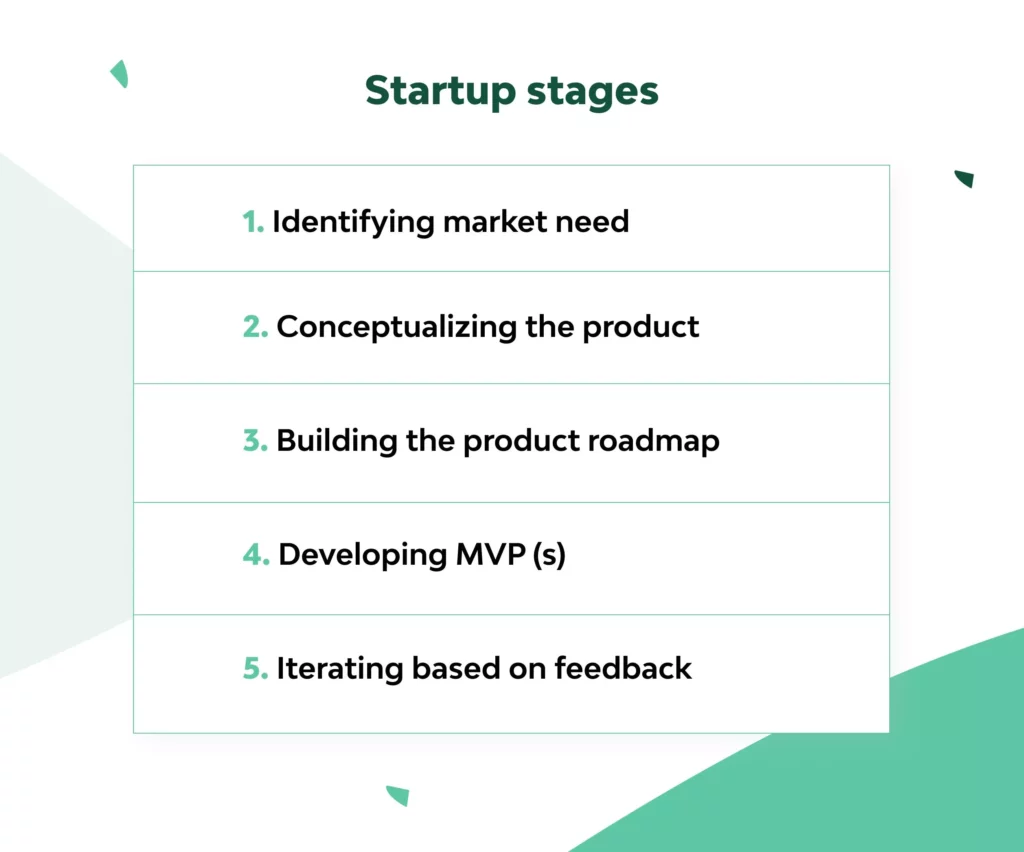
1. Identifying a Market Need
The truth is that not everyone is willing to buy what you are selling. So, while confidence is a huge advantage you still need to learn if there is a market need for your product. Identify your target audience, conduct market research and provide focus group testing. You want to know for sure who you are selling your product to and whether or not they want to spend money on it.
2. Conceptualizing the Product
At this stage, you have to conceptualize your idea just enough to receive meaningful customer feedback. It may be a one-page website or a Powerpoint presentation — test your concept’s problem/solution fit with potential customers.
3. Building the Product Roadmap
Once you’ve conceptualized the idea, it’s time to build a product roadmap. Basically, it is a strategic plan of your product development which contains all the key stages, plans, and business objectives. Why do you want to launch your product? Who is your target audience? Where do you start? Include these and other details regarding timing, product vision, and metrics into the roadmap.
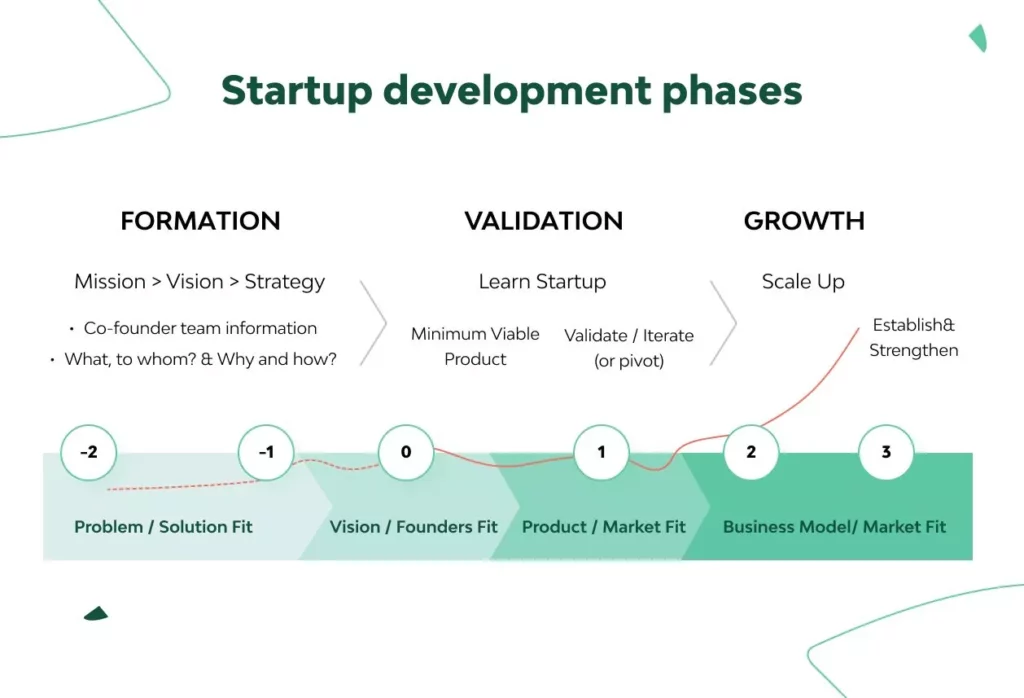
4. Developing a Minimum Viable Product (MVP) and Releasing it to Users
Then you have to focus on MVP product development process. Make it really basic, just the features you would need to test the product/market fit and get significant results. The goal is to collect user feedback about the product in general and understand what users like most about it.5. Iterating Based on User Feedback
Following the previous step, you should iterate again and again based on the user reaction. Take feedback from the last iteration and implement the necessary changes to the product. Continue to collect qualitative responses and test the product again. MVP project management requires improving the product until you get a perfect loveable version of it.Main Stages of Tech Startup Development
Since there are many different terms used to describe the development process it’s easy to get confused. Here, we’ll talk about key differences of the main startup stages from the perspective of end users, the tech team and the startup investor. Let’s get right into details.#1. MVP
The concept of MVP (minimum viable product) is widely used in the tech world. Let’s find out what it is and why your startup needs one.What is MVP and what it is NOT

You also get:
- Easy and cheap idea validation.Rather than releasing a full-fledged product that has a full set of features you can start with building an MVP. It is the cheapest form of a product and requires minimum features to test the idea and therefore — minimum time to build it. In other words, MVP aims to test and evaluate your idea, learn how the real world users are going to react to it.
- Room for change and evolution. With an MVP you have room for evolution. While you develop the product some new technologies may arise, so you can integrate extra features keeping the core idea in mind. Basically, you add value at each development stage and keep the product prototype flexible for the new changes.
- Possibility to test and experiment at low risk and cost.MVP is not for making a profit — it is about understanding what your product needs for succeeding. It doesn’t have to include all the features, just the ones you want to test. The best thing is that you can easily experiment with them to determine which of them work best and don’t spend a fortune on it.
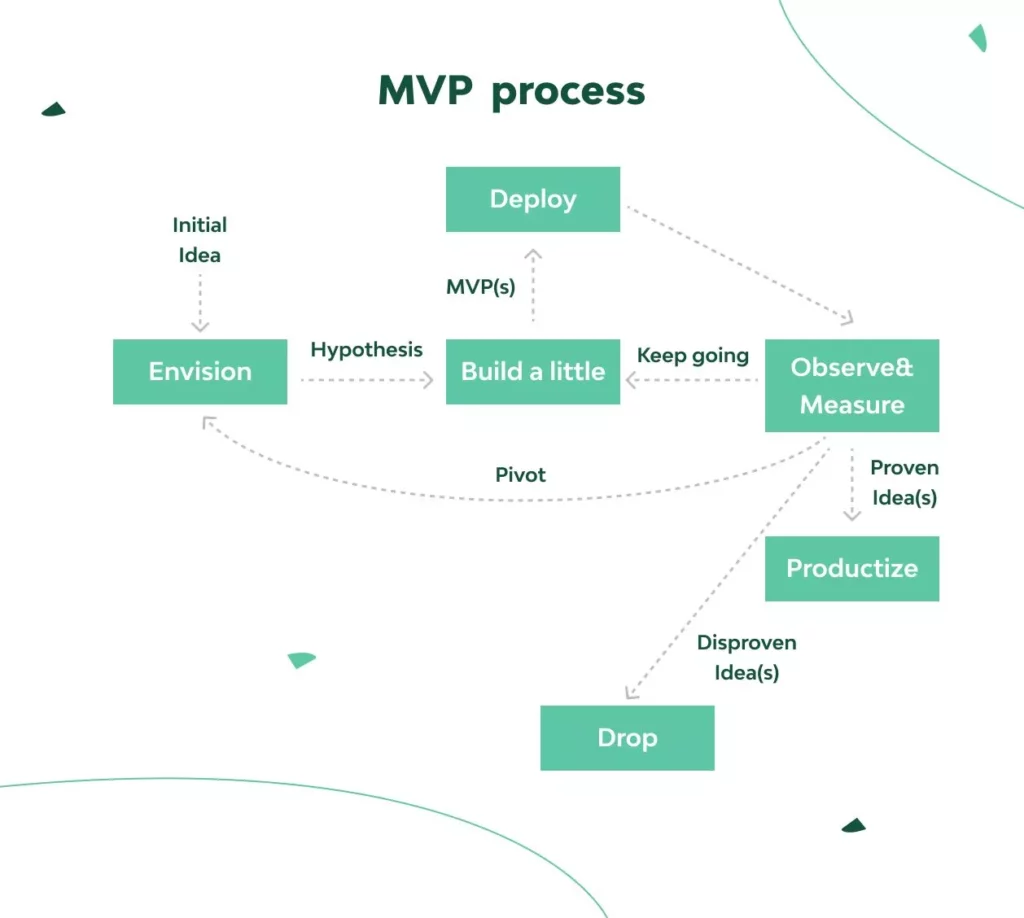
Valid Proof of your Idea to Stakeholders.
MVP is a showcase of what can become a larger, more complex product. It allows to demonstrate investors and stakeholders the market validity of your idea and assure them to invest in building up the end product.
User Expectations of an MVP
Generally, users have different levels of expertise, varied interests and expectations from the product. They might focus on various features and test ones they find the most interesting. Therefore you have to provide both qualitative and quantitative analysis — find out if the product solves customer problems and what steps users take in their user journey.
Qualitative Customer Feedback.
Target specific groups of users to get the most valuable qualitative feedback. For instance, you may want to hear from developers or decision makers regarding a certain piece of functionality. Are they satisfied with it? Does it solve their problem? Qualitative data will help you understand what can be improved in how you deliver value to the users.Quantitative analytics.
Quantitative data is typically collected from surveys, analytics tracking tools or by giving users a specific goal they have to accomplish. You have to record whether they could reach it or not, how long it took them and what obstacles were on their way. The quantitative results are easy to interpret and transform into valuable insights — you’d know which steps make the users stall and what pains they have in their product use journey.
Tech Team Expectations of an MVP

Developers struggle with the uncertainty of MVP and product potential. Therefore, its functional elements should be modular so that the technical team can easily fix any bugs in the future. It means the architecture has to be flexible and simple.
- Flexible architecture.A flexible architecture allows adding new features and ideas fast and at low cost — developers can quickly change an existing code base and improve the functionality. The product architecture should be scalable enough to implement changes based on user feedback.
- The entire high-level scope.The high-level scope defines the features and functions of a product. It basically sets what is relevant and what’s not and helps understand if there are any technical limitations to your ideas. Once you decide on the entire high-level scope of your product discuss it with engineers, seek their recommendations and advice.
- Customer analytics.Your product should meet customers expectations and a tech team should be aware of those expectations. Provide an analysis to define what features users expect to have and conduct future MVP development process based on the results.
- QA assistance.Sometimes it is difficult to see the “blind spots” when you are totally into the product. So, a QA analyst can be of great help. Invest in someone who is familiar with the product but works independently. This person will identify the features that should be improved and if there is anything you need to add. Besides, analyze competitors and learn what is your competitive advantage.
Team Support to Test the MVP
Engage your team into the discussion — what goes well and what doesn’t. Let everyone test the MVP version of the product and share their ideas. The tech team can benefit a lot from these results.
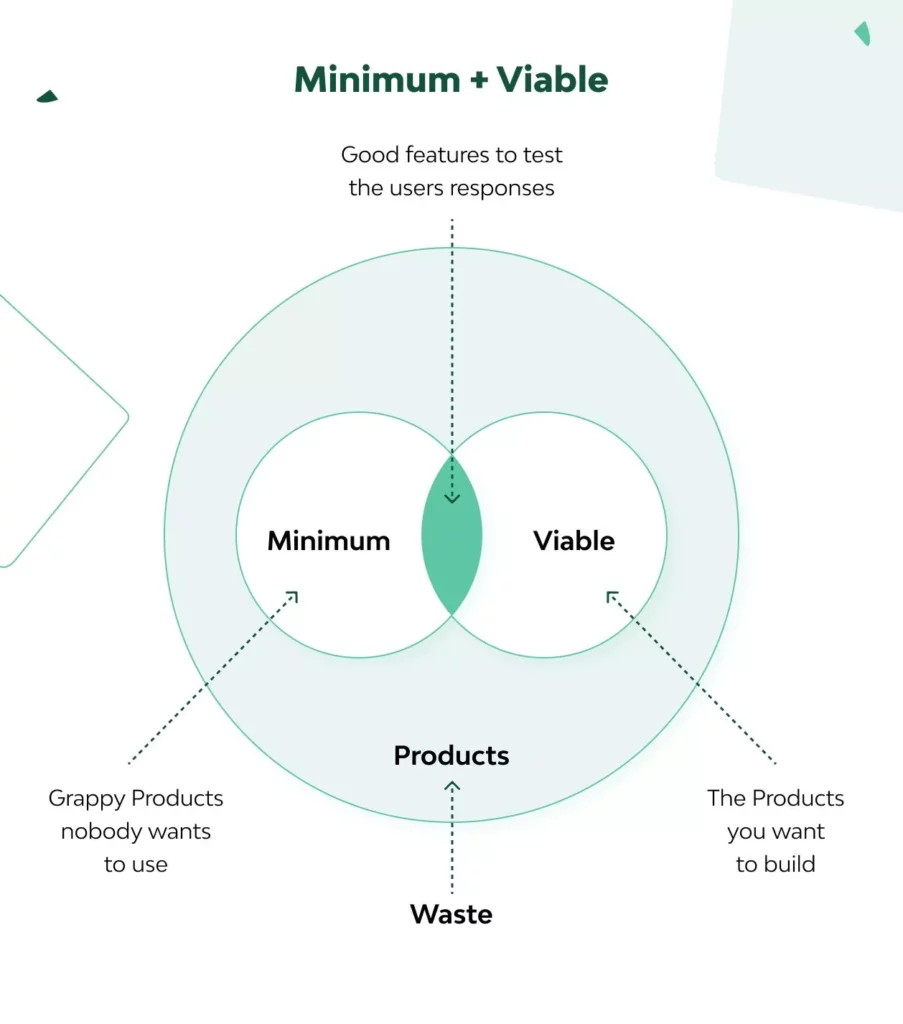
Investor Expectations of an MVP
If user tests are successful it’s time to present an MVP to investors. Investors want to see that a basic MVP grows into a real product. In other words, they want to secure their funds and therefore recognize early in the development process whether the product is viable or not.MVP Development Process
Having become familiar with the MVP concept and the essential criteria for users, developers, and investors, let’s briefly go through the main steps in MVP development for startups.Define the problem and do market research
Avoid the temptation to please everyone. Marketing research aims to clarify if your product has an audience and what the expectations of that audience are. What do your users really appreciate? What’s the main difference between your product and any competitor? Here are the two main questions you need to answer.Define the main features and prioritize them
Knowing user needs, you can consider how to provide them with it. Identify the key features that make your product attractive for users. (In advance, you can make assumptions about the MMF, which we will discuss below.) Prioritization is the key because you don’t need to make spendings to implement the full features list until you have tested the viability of the core idea when building MVP for startups.Validate your idea with a prototype
The main focus in startup MVP development is not to linger and move on to testing your assumptions as soon as possible. Start by developing a prototype, and make sure you have something attractive enough in terms of funding.Build, Measure, Learn
After building MVP, product development can benefit from comprehensively measuring. Track the metrics that matter most to you and keep the focus on what you’ve learned with each iteration. The most important thing here is to identify the solutions that really worked and develop your product in the right direction.#2. MMP and MMR
While an MVP in a startup is created to validate assumptions, MMP (minimum marketable product) and MMR (minimum marketable release) serve as a logical next step in the product development path.What is MMR and what is MMP
An MMR stands for minimum marketable release — a full release of a product that satisfies current user needs. While an MMR is used to shorten the initial time-to-market, the MMP (minimum marketable product or minimal marketable product) is able to deliver must-have functionality to users and bring quantifiable value back to the business. It’s a product that is developed to delight a group of few early adopters — a core target audience with specific needs.User Expectations of MMP/MMR
The MMP is aimed at people who are eager to try your product for novelty’s sake and who are willing to overlook the rough edges. The key is to focus on innovative features that this group seeks. At the same time, MMR (minimum marketable release) contains new features that can bring value to customers.Tech Team Expectations of MMP/MMR
First of all, MMP and MMR consist of only key features — you’ve collected the real customers’ advice and included what they want in the first version of your product. Basically, you let your product perform as the customers want.Investor Expectations of MMP/MMR
An MMP is the first iteration of the minimal marketable release. It reduces time-to-market, so investments can be safely made at this stage of product development. Even though the MMP is not a feature-rich product, investors still expect to have some cutting edge technologies that’ll serve as a strong competitive advantage. So, make sure you have those. MMP launch requires minimum funds so the risk of loss in case of underperformance is relatively low.#3. MMF
An MMF stands for a minimum marketable feature and defines a must-have feature of your product that will bring immediate value to the customer.What is MMF
Basically, MMF is a small set of functionality that has to be released to bring value to the customer. In terms of business, MMF enhances customer loyalty, helps you save costs and generate revenue.User Expectations of MMF
Users expect your product to have a feature that will address their pains easier, faster, cheaper, and more efficiently than alternative products’ features. Additionally, they want a noticeable new functionality — not just a bug fix or improvement of existing features, but a completely new exciting thing.Tech Team Expectations of MMF
The technical team has to create alpha and beta releases of the next major updates. This way they can resolve pains and complete tasks regarding the new features. They may even work on a separate MVPs but in general, one MVP can have several related MMFs combined.Investor Expectations of MMF
An MMF can help build the case for seed funding for an early-stage technology venture. Each MMF is a positive argument towards expanding the market size you can reach and as a result — the reason for attracting more funding. The more potential customers are interested in your particular MMF — the more of them will want to pay for it.#4. MLP, MDP, MAP
Want to see the finished product? You’re almost there. These startup stage acronyms stand for minimum loveable, minimum delightful and minimum awesome product respectively.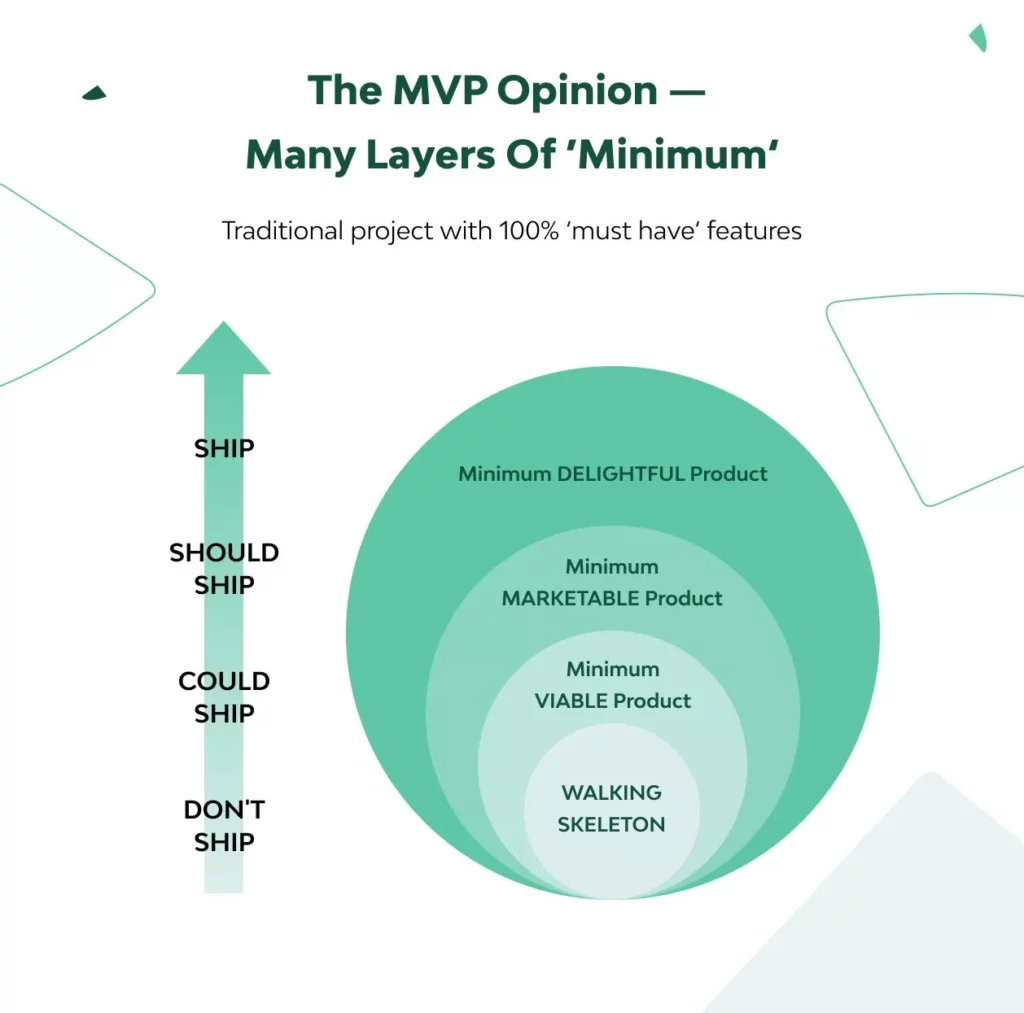
What are MLP, MDP, and MAP
An MLP, MDP, and MAP (minimum awesome product) are based on the idea that if users have first delightful product experience they’re going to use it more and what’s most important — tell others about it. Still, creating a wow-product is easier said than done. So, strive to focus not only on technically feasible but also awesome and loveable features that would make users pleased. In a nutshell, they would rather choose an awesome product than a dull, but a technically perfect one.User Expectations of MLP and MDP
In order to get customers hooked, communicate that despite being viable and technically feasible, your product is also cool. Create a catchy design to make it visually appealing, make the product user-friendly to provide a positive experience and add a wow-factor. Seek inspiration from Apple products, for instance.Tech Team Expectations for MLP, MDP, and MAP
At this stage of your startup, we’re forming an emotional reaction to the product. So it is crucial to have a great design created specifically for a target user. Therefore involve more design and UI/UX experts in the product development process. MLP and MDP are also about speed: gathering user feedback and rapidly implementing new features, so it is best to have a highly functioning Agile development team with the resources to rapidly react to the changes.Investor Expectations for MLP, MDP, and MAP
Investors want proof of the wow-effect to determine if the product MVP has reached the MLP or MDP level. Engage a group of passionate advocates proactively engaged with the product. They would prove stakeholders that product is perceived as lovable and delightful.Comparison Table: MVP Vs. MMP Vs. MLP Vs. MMF
To make it easier for you to navigate these abbreviations and understand the role of MVP in software development, take a look at the comparison table.| Type of minimum product | Stands for | Development speed | Features | Development price | Is built on |
| MVP | Minimum viable product | Fastest | Minimum to test the idea | Cheapest | The idea |
| MMP | Minimum marketable product | Fast | Minimum to sell the product | Cheap | Several MVPs |
| MMF | Minimum marketable feature | Fast | Minimum to bring immediate value to customers | Depends on the features | Feature description |
| MLP | Minimum lovable product | Fast (but can be slower than MVP) | Minimum to entice the wow-effect | Depends on the features | The MVP concept |
Here is a list of important things to remember.
- If possible, get a team experienced with MVPs;
- Validate your business idea;
- Listen carefully to any feedback given by users;
- Implement only minimum features that solve users’ problems;
- Do not underestimate a prototyping phase;
- Launch an MMP;
- Test the wow-effect of your product with MLP, MAP, and MDP.

